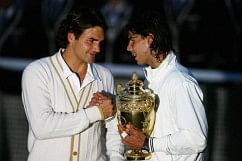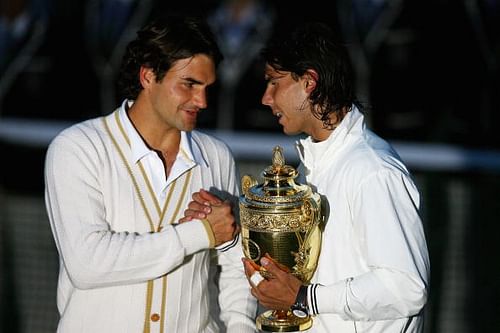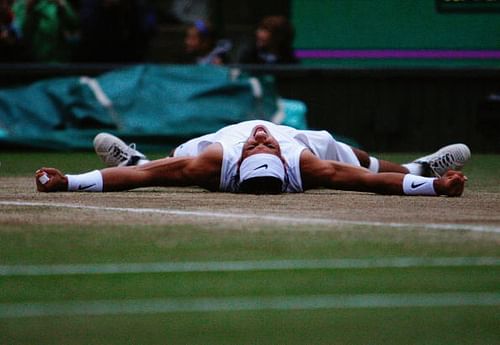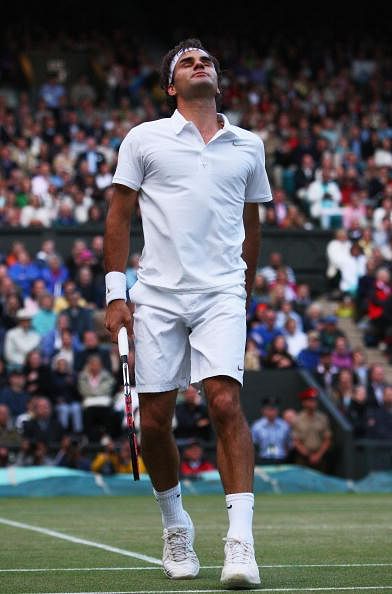
Sporting contests to Remember: The Changing of the Guard
“The battlefield is a scene of constant chaos. The winner will be the one who controls that chaos, both his own and the enemies.”
As rightly said by Napoleon Bonaparte, the famous French General and Emperor, the battle is won or lost only when one person or a party decides to step forward and take the necessary course of action. And on the 6th of July 2008, one man did step forward to win a tedious battle of epic proportions. After nearly 288 minutes of back-and-forth drama, Rafael Nadal was the winner of a truly amazing spectacle of a tennis match that had taken place at the Centre Court of the All England Lawn Tennis and Croquet Club in London, England, to determine the winner of the 122nd Wimbledon Championships.

LONDON – JULY 06: Roger Federer of Switzerland congratulates Rafael Nadal of Spain in winning the Championship trophy during the men’s singles Final on day thirteen of the Wimbledon Lawn Tennis Championships
Some readers might think that there is no necessity to apply such a comparison to a tennis match. But I can several counter-points to that. First of all, tennis is no longer in the just-another-sport category. It is a religion for thousands of people around the planet, including me. And those who witnessed the Wimbledon final contested between two men at the pinnacle of the sport will understand what I mean. Secondly, this match had the second highest number of viewers from the USA for a tennis match (the first being the 1980 marathon 5-set Wimbledon final between John McEnroe and Bjorn Borg, and it was mainly because McEnroe, an American, was in the final). Considering the fact that Americans are more into baseball and the NBA, and also that the match was being contested between two Europeans, it tells us about the level of play that was achieved by the two warriors.
The match had a lot of hype to live up to and it did not disappoint anyone (except for some Federer fans). I, for one, loved the way the match went on for the first two sets. Then came Roger’s saviour in the form of rain. He must have been praying for something like that, for he seemed to be at the near end of a comprehensive defeat and humiliation. He must have had visions about the ghosts of Roland Garros, which had haunted him for nearly a month. But nothing could be done about the rain and play was suspended. Roger and Rafa walked off into their abodes inside the locker room area, with Rafa the one with the advantage of having won the first two sets. After about 80 minutes of delay due to rain, both players were back on Centre court to continue to do battle. Roger had time to revise and reassess his strategy to counter Rafa’s sharp and heavy groundstrokes. And Roger did turn himself into the mitigator of his own misery. He had thought and plotted a way to unsettle the miscreant in his nightmares. The memorabilia – the 5 Wimbledon trophies that this tournament had given him – rekindled the Emperor’s desire within him, and he showed the will to fight with all his heart and might.
Roger won the third set on a tie-break, thanks to an ace. He won the fourth set also on a tie-break, saving two championship points against Rafa, the second of which was pure magic, and achieving an almost impossible escape from the deepest of trenches. But the irrepressible force that is Rafa never backed down. Rafa was a proven competitor and, at the tender age of 22, had received various accolades for his mental toughness. The loss of the fourth set after having two championship points, and after being two sets up against the five-time defending champion and world no. 1, would have withered the composure and concentration of many a man and turned them into embodiments of dejection. But Rafa was anything but dejected. The fifth set started with Roger serving, thus giving him a distinct advantage on Rafa’s serve. One break of Rafa’s serve and Roger could have been beyond Rafa’s reach. At 2-2, 40-40, the heavens opened up again and the match was called off again. Roger and Rafa returned to their locker rooms. After about half an hour, play resumed and Roger aced himself out of trouble again. The match continued on serve without much trouble for Rafa while Roger’s serve was always under threat from Rafa. But time and again Roger served himself out of difficulty. On Rafa’s serve at 4-5, 30-30, Roger was two points away from a record-breaking sixth consecutive Wimbledon title. But Rafa showed everyone why he had been so consistent the past 2 months by taking the game to Roger with his improved serve. The match went on serve until 7-7. Roger saved 3 break points, but was unable to hold on to his service game, as Rafa finally broke the mighty Federer serve to go up 8-7. On Rafa’s serve, Roger saved one more championship point with an ethereal backhand return winner against an impressive serve down the left service line. But Rafa wasn’t to be denied again, and as Roger netted a regulation forehand, it was ironic that Rafa, the new champion, fell down on the Centre Court floor in ecstasy and elation, as he always does on his beloved clay, to celebrate his win while Roger, the fallen champion, stood with a visibly sad face on the other side of the court. Finally Rafael Nadal had become the new Wimbledon champion; a champion from Spain after 42 long years. It took the perfect mixture of power, technique, finesse, and prowess for Rafa to derail the defending champion, which was the only way to keep Roger strangulated for over four and a half hours.

LONDON – JULY 06: Rafael Nadal of Spain celebrates winning match point and the Championship during the men’s singles Final match against Roger Federer of Switzerland
This is a huge match report but I just couldn’t hold myself back. The entire point of this match and my article was to tell the world what those two players aimed to achieve. Nadal’s ambition was to be the first man since the legendary Swede Bjorn Borg in 1980, and the second man in the Open Era, to win Roland Garros and Wimbledon in the same calendar year. He had craved for a place alongside Borg in the record books. Roger had also aimed to cement his place in the annals of history as the first man in the Open Era to win 6 Wimbledon titles in a row. But the civilized Swiss had to settle for a place alongside Borg like Rafa for the time being. Borg, of course, had achieved this awe-inspiring Roland Garros-Wimbledon double feat three times in a row from 1978 to 1980, and Rafa was still a long way from even imagining himself at the end of such a divine path of success.
 The segment of this article which I really want to focus on is the conclusion. Rafa was 22 then. Roger turned 27 a month later. Roger, had he been able to win the 2008 Wimbledon, would have had a lot to be excited and joyful about. He would have had 13 Grand Slam titles, which would certainly have boosted his morale and it would have been full throttle ahead for the Swiss as he continued his record-breaking climb of Mount Sampras. The establishment of Mount Federer seemed not too far away, but this match made it seem as if everything was falling apart and the peak of Mount Sampras was fading and disappearing right before Roger’s eyes. Everyone started talking about Rafa and how he might have been able to achieve what Roger had been trying to achieve for a few years then, i.e. win the Career Grand Slam (win all of the four Grand Slams in tennis). Even though both men have achieved the Career Grand Slam now, this match proved to be pivotal as the Federer-Nadal rivalry grew in stature and became arguably the greatest sporting rivalry at the time, and resulted in this match getting the acclaim as the greatest tennis match ever. The mental fatigue and misery that Rafa single-handedly managed to subject Roger to was very evident as another defeat at the hands of Rafa in the 2009 Australian Open culminated in Roger weeping inconsolably. The physical toll it took on Rafa to wrestle titles away from Roger resulted in tendinitis on both knees for the Spaniard. But after all this, the hug they shared at the end of this epic showed how classy these two are. The respect and the friendship that these two have for each other gave this rivalry a freshness which was something never before seen in sport. The two have since gone on to break several records since. This battle was won by Rafa, but the war was still on. And to this day, people still keep referring to the 2008 Wimbledon final as the gold standard of tennis duels.
The segment of this article which I really want to focus on is the conclusion. Rafa was 22 then. Roger turned 27 a month later. Roger, had he been able to win the 2008 Wimbledon, would have had a lot to be excited and joyful about. He would have had 13 Grand Slam titles, which would certainly have boosted his morale and it would have been full throttle ahead for the Swiss as he continued his record-breaking climb of Mount Sampras. The establishment of Mount Federer seemed not too far away, but this match made it seem as if everything was falling apart and the peak of Mount Sampras was fading and disappearing right before Roger’s eyes. Everyone started talking about Rafa and how he might have been able to achieve what Roger had been trying to achieve for a few years then, i.e. win the Career Grand Slam (win all of the four Grand Slams in tennis). Even though both men have achieved the Career Grand Slam now, this match proved to be pivotal as the Federer-Nadal rivalry grew in stature and became arguably the greatest sporting rivalry at the time, and resulted in this match getting the acclaim as the greatest tennis match ever. The mental fatigue and misery that Rafa single-handedly managed to subject Roger to was very evident as another defeat at the hands of Rafa in the 2009 Australian Open culminated in Roger weeping inconsolably. The physical toll it took on Rafa to wrestle titles away from Roger resulted in tendinitis on both knees for the Spaniard. But after all this, the hug they shared at the end of this epic showed how classy these two are. The respect and the friendship that these two have for each other gave this rivalry a freshness which was something never before seen in sport. The two have since gone on to break several records since. This battle was won by Rafa, but the war was still on. And to this day, people still keep referring to the 2008 Wimbledon final as the gold standard of tennis duels.